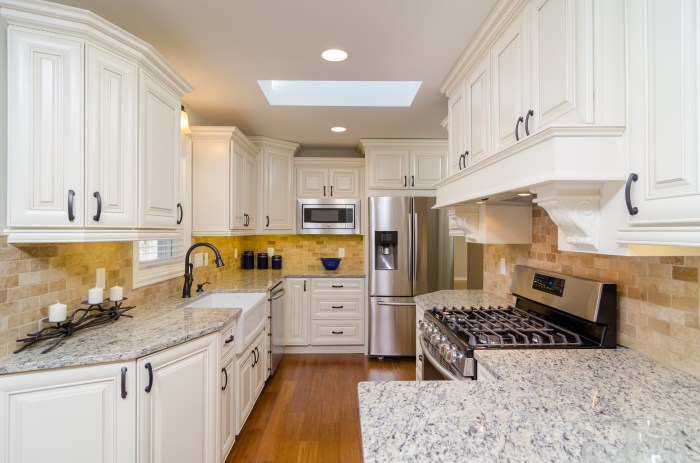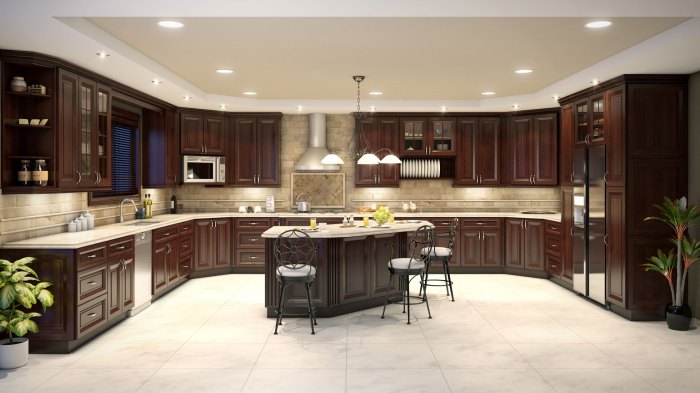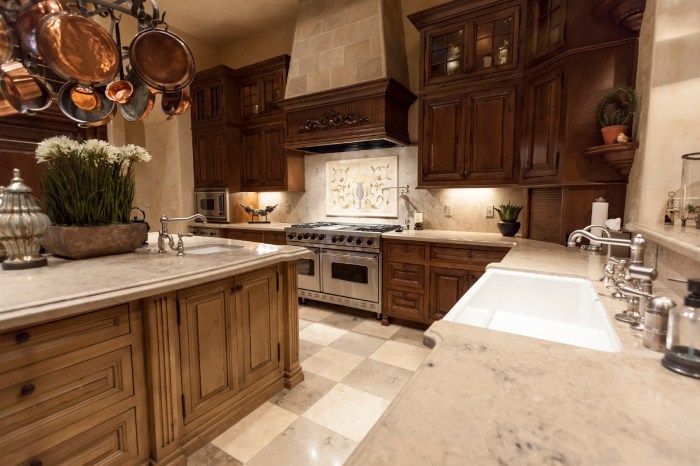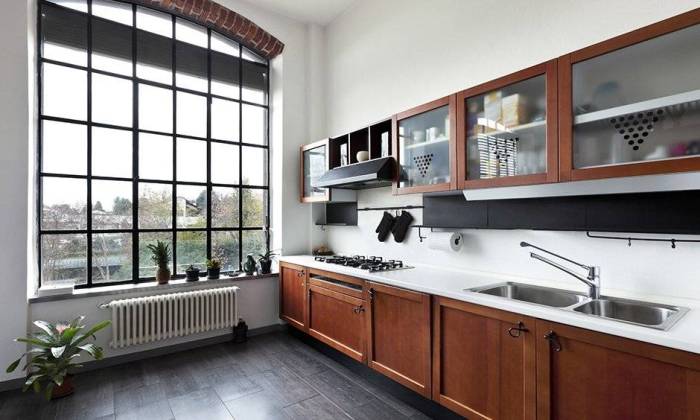Wooden kitchen cabinets, far from mere storage solutions, represent a captivating blend of artistry, functionality, and enduring material science. Their design, a testament to centuries of craftsmanship and evolving technological advancements, reflects personal style while demanding careful consideration of wood type, finish, and layout. This exploration delves into the multifaceted world of wooden kitchen cabinet design, examining the historical context, diverse stylistic approaches, and practical considerations crucial for achieving a kitchen that is both aesthetically pleasing and highly functional.
From the enduring elegance of Shaker-style cabinets to the modern minimalism of sleek, handleless designs, the choices are vast. Understanding the properties of various wood species—their durability, cost, and maintenance requirements—is paramount. Similarly, selecting the appropriate finish, whether a rich stain, protective varnish, or vibrant paint, significantly impacts the cabinet’s longevity and visual appeal. Finally, efficient space planning and the strategic placement of cabinets are critical to optimizing kitchen workflow and maximizing storage capacity.
This guide provides a detailed roadmap to navigate these choices, empowering you to design a kitchen that perfectly reflects your unique vision and needs.
Popular Wooden Kitchen Cabinet Styles

The enduring appeal of wooden kitchen cabinets lies in their versatility, durability, and ability to complement diverse design aesthetics. From the rustic charm of farmhouse styles to the sleek minimalism of contemporary designs, wooden cabinets offer a spectrum of options to personalize a kitchen’s character. Understanding the nuances of different styles allows homeowners to make informed decisions that align with their individual tastes and the overall ambiance of their homes.
The following sections detail five popular wooden kitchen cabinet styles, exploring their defining characteristics and historical influences. These styles represent a cross-section of design trends, showcasing the adaptability of wood as a material in kitchen cabinetry.
Five Distinct Wooden Kitchen Cabinet Styles
The selection of a kitchen cabinet style significantly impacts the overall aesthetic of the space. The following table summarizes five distinct styles, highlighting their key features.
| Style Name | Door Style | Hardware Style | Overall Aesthetic |
|---|---|---|---|
| Shaker | Simple, flat-panel doors with recessed center panels | Simple knobs or bin pulls, often in dark metal or wood | Clean, minimalist, and timeless; blends seamlessly with various design schemes |
| Farmhouse | Raised-panel doors, often with distressed or antiqued finishes | Larger knobs or pulls, sometimes with decorative elements; often in black or brushed nickel | Rustic, warm, and inviting; emphasizes natural materials and a sense of history |
| Contemporary | Slab doors (flat, frameless) or minimalist frame-and-panel doors | Sleek, minimalist handles or integrated pulls; often in brushed metal or stainless steel | Clean, modern, and sophisticated; focuses on functionality and streamlined design |
| Traditional | Raised-panel or ornate doors with decorative moldings and carvings | Ornate knobs or pulls, possibly with decorative elements; often in brass or polished nickel | Elegant, formal, and classic; emphasizes craftsmanship and intricate details |
| Craftsman | Simple, solid wood doors with exposed wood grain and often featuring tapered legs and decorative detailing | Simple, yet substantial, knobs and pulls; often in dark metal or wood to complement the richness of the wood | Rustic elegance, blending natural materials with simple yet sophisticated design elements |
Historical Context and Evolution of Three Prominent Wooden Kitchen Cabinet Styles
The evolution of kitchen cabinet styles reflects broader shifts in design aesthetics and societal preferences. Three prominent styles—Shaker, Farmhouse, and Traditional—illustrate this dynamic interplay of historical context and design innovation.
Shaker Style: Originating in the 18th and 19th centuries with the Shaker religious community, Shaker cabinets are characterized by their simple, functional design. The focus on clean lines and unadorned surfaces reflects the Shaker belief in simplicity and practicality. The use of simple, durable wood and minimal hardware exemplifies their philosophy of honest craftsmanship. Over time, the Shaker style has transcended its religious origins, becoming a timeless design choice appreciated for its elegance and versatility.
Farmhouse Style: Rooted in the practical needs of rural life, farmhouse cabinets emerged as a response to the functionality required in a working kitchen. Their robust construction, often using reclaimed wood and distressed finishes, conveys a sense of history and resilience. The incorporation of raised-panel doors and decorative hardware reflects a desire for both practicality and aesthetic appeal. The style’s enduring popularity stems from its ability to create a warm, inviting atmosphere that evokes a sense of nostalgia and comfort.
Traditional Style: Traditional kitchen cabinets draw inspiration from various historical periods, often incorporating ornate details and decorative moldings. The emphasis on craftsmanship and the use of high-quality materials reflect a desire for elegance and sophistication. While rooted in the past, traditional styles often incorporate modern conveniences and functionalities, creating a harmonious blend of old-world charm and contemporary practicality. The evolution of this style reflects ongoing adaptations to meet changing tastes while maintaining a sense of timeless appeal.
Visual Description of a Shaker Style Wooden Kitchen Cabinet
Imagine a Shaker-style cabinet, constructed from solid, light-colored wood like maple or pine. The door is a simple, flat-panel design, with a recessed center panel framed by a slightly raised border. The wood grain is subtly visible, showcasing the natural beauty of the material. The cabinet’s construction is robust, with dovetail joinery used for strength and durability. The hardware is understated – a simple, round, dark bronze knob is centrally positioned on the door, adding a touch of elegance without detracting from the overall simplicity of the design.
The cabinet’s clean lines and uncluttered appearance exude a sense of calm and order, perfectly reflecting the Shaker philosophy of simplicity and functionality. The overall effect is one of understated elegance and timeless appeal, making it a versatile choice for various kitchen designs.
Wood Types and Finishes for Kitchen Cabinets
The selection of wood type and finish for kitchen cabinets is a crucial design decision impacting both aesthetics and longevity. The inherent properties of the wood, combined with the protective and decorative qualities of the finish, determine the cabinet’s resistance to wear, tear, and the overall look and feel of the kitchen. Understanding these factors allows for informed choices that align with personal preferences and budgetary constraints.
The following sections delve into the properties of several popular wood types and the effects of various finishes, providing a framework for making informed decisions in kitchen cabinet design.
Wood Type Properties
The choice of wood significantly influences the durability, cost, and maintenance requirements of kitchen cabinets. Different species possess unique characteristics related to grain, density, and inherent hardness, directly impacting their performance in a high-use environment like a kitchen.
| Wood Type | Durability | Cost | Maintenance |
|---|---|---|---|
| Oak | High; dense and hard, resistant to dents and scratches. | Medium to High | Moderate; requires regular cleaning and occasional refinishing. |
| Cherry | Medium to High; relatively hard, but susceptible to dents if not finished properly. | High | Moderate; prone to darkening with age and exposure to sunlight; requires careful cleaning. |
| Maple | High; very hard and dense, highly resistant to wear. | Medium to High | Low; relatively easy to clean and maintain. |
| Pine | Low to Medium; softer wood, prone to dents and scratches. | Low | High; requires more frequent refinishing due to its softness. |
| Walnut | High; dense and hard, with beautiful grain patterns. | High | Moderate; requires regular cleaning and occasional refinishing; susceptible to staining. |
Wood Finish Types and Their Impact
The finish applied to the wood significantly impacts both the visual appeal and the longevity of the cabinets. Different finishes offer varying degrees of protection against moisture, scratches, and UV damage, influencing the overall maintenance required.
Five common wood finishes, each offering unique properties and aesthetic results, are described below.
- Stain: Penetrates the wood, enhancing the natural grain and color. Offers minimal protection. Requires a topcoat for durability.
- Paint: Provides a durable, opaque finish that hides the wood grain. Offers excellent protection against moisture and scratches. Requires proper surface preparation.
- Varnish: A transparent finish that protects the wood while allowing the grain to show through. Offers good protection against moisture and scratches. Can yellow over time.
- Lacquer: A fast-drying, hard finish that provides excellent protection and a smooth, glossy surface. Resistant to scratches and moisture. Requires careful application.
- Wax: A soft finish that provides minimal protection but enhances the natural beauty of the wood. Easy to apply and repair. Not suitable for high-traffic areas.
Applying a Two-Part Polyurethane Finish
Two-part polyurethane finishes offer exceptional durability and protection against moisture and wear. The process typically involves several steps to ensure a high-quality, long-lasting finish.
- Surface Preparation: The wood must be thoroughly sanded to a smooth surface, removing any imperfections or previous finishes. Dust is removed with a tack cloth.
- Mixing the Polyurethane: The two components (resin and hardener) are carefully mixed according to the manufacturer’s instructions. Thorough mixing is crucial for proper curing.
- Application: The polyurethane is applied in thin, even coats using a brush, roller, or spray gun. Allow ample drying time between coats, as specified by the manufacturer.
- Sanding (Optional): Light sanding between coats can help achieve a smoother finish. Use fine-grit sandpaper and remove dust thoroughly.
- Final Coat: Apply a final coat of polyurethane for added protection and durability. Allow for sufficient drying time before use.
Cabinet Design Elements and Functionality

The functionality and aesthetic appeal of a kitchen are intrinsically linked to the design and placement of its cabinets. Effective cabinet design considers not only storage capacity but also workflow efficiency, accessibility, and the overall visual harmony of the space. Careful consideration of these elements ensures a kitchen that is both beautiful and practical.
Kitchen Cabinet Layouts for Varying Kitchen Sizes
The optimal kitchen cabinet layout is heavily influenced by the available space. A poorly planned layout in a small kitchen can feel cramped and inefficient, while a poorly planned layout in a large kitchen can lead to wasted space and an uninviting feel. Therefore, tailoring the design to the specific dimensions of the kitchen is paramount.
- Small Kitchen Layout (Galley Style): This linear layout maximizes space utilization in narrow kitchens. Cabinets are installed along two parallel walls, creating a galley-like structure. Features include:
- Maximized wall space for storage.
- Efficient workflow: Prep area, cooking area, and cleaning area are positioned linearly.
- Potential for integrated appliances (e.g., dishwasher, oven).
- Medium Kitchen Layout (L-Shaped): An L-shaped layout offers a good balance between storage and work triangle efficiency. Cabinets are installed along two adjacent walls forming an “L” shape. Features include:
- Ample storage space along two walls.
- Natural formation of a work triangle (sink, stove, refrigerator).
- Flexibility in appliance placement.
- Potential for an island or peninsula for additional workspace and storage.
- Large Kitchen Layout (U-Shaped or Island): Larger kitchens benefit from U-shaped layouts or layouts incorporating islands. U-shaped layouts utilize three walls for cabinets, while island layouts add a central workspace and storage. Features include:
- Extensive storage capacity along three walls (U-shaped) or with additional island cabinetry.
- Ample counter space for multiple cooks or large gatherings.
- Enhanced workflow efficiency due to generous counter space and well-defined zones.
- Potential for incorporating specialized cabinets (e.g., pantry cabinets, appliance garages).
Impact of Cabinet Door and Drawer Hardware on Kitchen Design
Cabinet hardware is more than just functional; it significantly impacts the overall aesthetic and feel of the kitchen. The style, material, and finish of the hardware can dramatically alter the perceived tone of the space, ranging from sleek and modern to rustic and traditional.The choice of hardware should complement the overall kitchen style. For instance, sleek, minimalist bar pulls suit modern kitchens, while ornate knobs and pulls complement traditional or farmhouse styles.
Materials range from brushed nickel and stainless steel for a contemporary look to antique brass or copper for a warmer, more vintage feel. Examples include cup pulls, knobs, bar pulls, and apron-front pulls, each offering a distinct visual character.
Maximizing Storage Space in Kitchen Cabinets
Efficient storage is crucial, especially in smaller kitchens. Clever design and the incorporation of space-saving solutions can significantly enhance storage capacity.
- Pull-out shelves and drawers: These maximize accessibility to items stored in deeper cabinets, eliminating the need to rummage in the back.
- Corner cabinets with specialized organizers: These often-underutilized spaces can be optimized with rotating shelves or pull-out corner units.
- Vertical storage solutions: Utilizing vertical space with tall cabinets and narrow shelving units increases storage density.
- Drawer dividers and organizers: These keep utensils, cookware, and other items neatly organized, preventing clutter and maximizing space efficiency.
- Cabinet risers: These raise items stored on shelves, creating additional space underneath.
Wooden Kitchen Cabinet Trends and Inspirations

The realm of kitchen design is a dynamic landscape, constantly evolving to reflect shifting aesthetic preferences and technological advancements. Wooden kitchen cabinets, a timeless classic, remain central to this evolution, adapting to incorporate modern trends and innovative design solutions. Understanding these trends allows homeowners and designers to create kitchens that are both stylish and functional, reflecting personal tastes while leveraging the enduring appeal of wood.
Current Trends in Wooden Kitchen Cabinet Design
Three significant trends currently shape the design of wooden kitchen cabinets. These trends reflect a multifaceted approach, balancing the desire for both classic elegance and contemporary functionality.
- The Rise of Two-Tone Cabinets: This trend involves using two different colors or finishes on upper and lower cabinets. For instance, dark navy blue lower cabinets paired with light, creamy white upper cabinets create a visually striking contrast, enhancing the feeling of spaciousness in smaller kitchens. The scientific principle at play here is contrast perception; the juxtaposition of light and dark colors draws the eye and creates a dynamic visual experience.
This trend leverages the principles of color theory to optimize the spatial perception of the kitchen.
- The Embrace of Natural Wood Grains: A reaction against overly uniform finishes, this trend emphasizes the unique character and beauty of natural wood grain. Instead of heavily stained or painted cabinets, designers are increasingly showcasing the inherent patterns and textures of wood species like oak, walnut, and cherry. This reflects a broader societal shift toward natural materials and sustainable design practices. The aesthetic appeal lies in the inherent irregularity and visual richness of the wood grain, offering a sense of authenticity and handcrafted quality.
- The Integration of Smart Storage Solutions: Modern kitchen design emphasizes maximizing space and functionality. This trend manifests in wooden cabinets incorporating innovative storage solutions like pull-out pantries, spice racks, and internal drawer dividers. These solutions optimize storage capacity and improve accessibility, aligning with principles of ergonomic design. The incorporation of such features significantly enhances the usability and efficiency of the kitchen space, reducing wasted time and effort.
Innovative Design Solutions in Modern Wooden Kitchen Cabinets
The integration of innovative design solutions enhances both the functionality and aesthetic appeal of modern wooden kitchen cabinets. These solutions often blend form and function seamlessly.
- Integrated Appliances: Seamlessly integrating appliances, such as microwaves or ovens, into the cabinet design creates a streamlined and sophisticated look. This approach maximizes space utilization and minimizes visual clutter, enhancing the overall aesthetic coherence of the kitchen.
- Open Shelving with Wooden Accents: Combining closed cabinets with open shelving provides a balance between storage and display. Wooden accents on the shelving units add warmth and visual interest, complementing the overall cabinet design.
- Customizable Cabinet Interiors: Offering adjustable shelving and drawer dividers allows homeowners to tailor their cabinet interiors to their specific needs. This flexibility enhances functionality and organization, catering to individual preferences and storage requirements.
- Soft-Close Hinges and Drawers: These features enhance both the usability and longevity of the cabinets, minimizing noise and preventing damage from slamming doors and drawers. The incorporation of these features exemplifies attention to detail and a commitment to superior quality.
- Hidden Lighting: Subtle under-cabinet lighting enhances visibility and creates a warm, inviting atmosphere. This approach uses light strategically to highlight the cabinet design and enhance the overall ambiance of the kitchen.
Inspirational Wooden Kitchen Cabinet Designs
The following descriptions illustrate the diverse range of styles and design elements used in creating visually appealing wooden kitchen cabinets.
- Image 1: Rustic Farmhouse Style: This design features warm-toned oak cabinets with a distressed finish, creating a cozy and inviting atmosphere. The color palette is dominated by earthy browns and creams, complemented by black hardware. The overall style evokes a sense of traditional craftsmanship and rural charm.
- Image 2: Modern Minimalist Style: Sleek, white-painted cabinets with clean lines and minimalist hardware define this style. The color palette is simple and elegant, with white dominating and accented by stainless steel appliances. The overall impression is one of sophistication and understated elegance.
- Image 3: Contemporary Shaker Style: This design incorporates the classic Shaker style with a modern twist. The cabinets are painted a deep gray, creating a dramatic contrast against lighter countertops. The clean lines and simple detailing of the Shaker style are retained, providing a timeless appeal.
- Image 4: Transitional Style with Walnut Cabinets: Rich, dark walnut cabinets create a warm and sophisticated ambiance. The style blends traditional and modern elements, with ornate crown molding paired with sleek, brushed nickel hardware. The color palette is centered around the deep brown of the walnut, complemented by lighter countertops and backsplash.
- Image 5: Coastal Style with White Cabinets and Light Wood Accents: This design evokes a relaxed and airy feel with crisp white cabinets and light-colored wood accents. The color palette consists of whites, creams, and soft blues, reflecting the colors of the sea and sky. The overall style conveys a sense of calm and serenity.
Maintenance and Care of Wooden Kitchen Cabinets

Wooden kitchen cabinets, a hallmark of enduring style and quality, require diligent care to maintain their beauty and structural integrity. The natural properties of wood, while aesthetically pleasing, make it susceptible to damage from moisture, scratches, and everyday wear and tear. Proper maintenance, however, can significantly extend the lifespan of these valuable fixtures, preserving their value and enhancing the overall appeal of your kitchen.
This section details effective cleaning techniques, addresses common problems, and provides practical solutions for minor repairs.
Cleaning and Maintaining Wooden Kitchen Cabinets
Regular cleaning is paramount to preventing the accumulation of grime and grease that can damage the wood’s finish. A gentle approach is crucial; harsh chemicals can strip the protective layer, leaving the wood vulnerable. Begin by dusting the cabinets weekly with a soft, dry microfiber cloth. For more thorough cleaning, mix a mild dish soap solution (a few drops of mild dish soap in warm water) and apply it to the cloth, gently wiping down the surfaces.
Always wring out excess water to prevent water damage. After cleaning, immediately dry the cabinets with a clean, dry microfiber cloth, paying close attention to any crevices or joints where moisture might accumulate. Avoid using abrasive cleaners or scouring pads, as these can scratch the delicate finish. For stubborn stains, a paste of baking soda and water can be gently applied, left for a few minutes, then wiped clean with a damp cloth followed by thorough drying.
Polishing with a wood-specific polish, applied sparingly and buffed to a shine, can enhance the cabinets’ luster and provide additional protection. This routine maintenance will help prevent the build-up of dirt and grease, keeping your cabinets looking their best.
Addressing Common Problems: Scratches and Water Damage
Scratches are an inevitable part of kitchen life, especially on high-traffic areas of wooden cabinets. Minor scratches can often be addressed with a simple touch-up using a wood-specific marker or stain that matches the cabinet’s finish. For deeper scratches, a more involved repair might be necessary, potentially involving sanding and refinishing the affected area. Water damage, on the other hand, is a more serious issue.
Even small amounts of standing water can penetrate the wood, causing warping, swelling, and discoloration. Immediate action is crucial; blot up any spills immediately with a clean cloth. If the wood has absorbed significant moisture, allowing it to air dry completely is vital, and professional intervention may be required in severe cases. Prevention is key; avoid placing wet items directly on the cabinets and ensure proper ventilation in the kitchen to minimize humidity.
Repairing Minor Damage: A Step-by-Step Guide
Repairing a small scratch on a wooden cabinet involves several steps. First, clean the scratched area thoroughly with a damp cloth to remove any dirt or debris. Next, gently sand the scratch with fine-grit sandpaper (220-grit or higher), working in the direction of the wood grain to avoid further damage. This will smooth the surface and blend the scratch.
After sanding, wipe the area clean with a tack cloth to remove dust particles. Apply a wood filler, if necessary, to fill any deeper scratches. Once the filler is dry, sand it smooth with fine-grit sandpaper. Finally, apply a touch-up stain or marker that matches the cabinet’s finish. Allow the stain to dry completely before applying a protective sealant or clear coat to protect the repaired area.
This process restores the cabinet’s appearance, minimizing the visibility of the scratch.
Final Summary
Designing the perfect wooden kitchen cabinet is a journey that intertwines historical influences with modern innovation, artistic sensibility with practical considerations. By carefully weighing the aesthetic appeal of different styles, the durability and cost-effectiveness of various wood types and finishes, and the functional needs of your kitchen space, you can create a stunning and enduring centerpiece for your home.
This exploration has highlighted the importance of understanding the intricate details—from historical styles to contemporary trends, from wood selection to finish application—that contribute to the overall success of your wooden kitchen cabinet project. The result? A kitchen that is not just beautiful but also functional, a space where practicality and style converge in harmonious perfection.
FAQ
What is the average lifespan of a well-maintained wooden kitchen cabinet?
With proper care, wooden kitchen cabinets can last for 50 years or more, sometimes even exceeding a century depending on the wood type and construction.
Can I install wooden kitchen cabinets myself?
While possible for some with experience, professional installation is generally recommended for complex designs or larger kitchens to ensure proper alignment and functionality.
How often should I clean my wooden kitchen cabinets?
Regular dusting (weekly) is ideal. A more thorough cleaning with a damp cloth and mild soap should be done monthly, avoiding excessive water.
What are some eco-friendly options for wooden kitchen cabinets?
Look for cabinets made from sustainably sourced wood certified by organizations like the Forest Stewardship Council (FSC). Consider reclaimed wood as a highly sustainable option.
How can I prevent water damage to my wooden kitchen cabinets?
Promptly wipe up spills, use sealant on countertops and backsplashes, and ensure proper ventilation to prevent moisture buildup.
